Top News
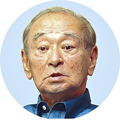
December 28, 2011 Compiled from reports in the Ryukyu Shimpo
In a New Year’s interview on December 27, Okinawa Governor Hirokazu Nakaima indicated that he will reject the application to reclaim the coastal area of Henoko in Nago that has been decided upon as the site for relocation of the United States Marine Corps Air Station Futenma. He said, “There is no way that I will be forced to accept this application.”
In response to the central government’s view that if necessary it could use the Local Autonomy Act to sidestep the need to get permission from the governor of Okinawa, and thereby execute by proxy to get approval for the application, Nakaima said, “To be honest, I do not think it is possible for the central government to do that.”
With regard to the application for the reclamation of the coastal area of Henoko, Nakaima said, “I have no intention of changing my policy pledge demanding the relocation of Futenma Air Station to a location outside Okinawa and I do not think that the submission of the Henoko environmental impact report affects that stance in any way.” He went on to say, “I will never be in a situation in which I would approve this application. I cannot see anything happening that would make me suddenly change my mind.”
With regard to the central government’s claim that it could execute by proxy and approve the application, Nakaima said, “In general terms, the central government could only execute by proxy if the implementation of statutory work entrusted to the prefectural government were illegal or not in the public interest. We are getting the vice governor, who is in charge of this matter, study the central government’s view.” He continued, “I honestly do not think that the central government can go down that track.”
(English translation by T&CT, Mark Ealey)
Go To Japanese
Citizens’ groups prevent Ministry of Defense from submitting Henoko environmental impact report
December 28, 2011 Compiled from reports in the Ryukyu Shimpo
On December 27, the Ministry of Defense commissioned a delivery company to take the written evaluation on the environmental impact of the reclamation of the coastal area of Henoko in Nago to the Okinawa Prefectural Office. However the van found itself surrounded by citizens who had packed themselves into the Office to prevent the submission of the report. The Prefectural Government asked the Okinawa Defense Bureau to turn the van away in order to avoid trouble, so it headed away without submitting the report. That same day, Chairman of Okinawa Prefectural Assembly Zenshin Takamine and heads of various citizens’ group remonstrated against the submission of the evaluation report. Takamine strongly criticized the central government, saying, “The Okinawan people are extremely angry with the central government for the way it has ignored the Okinawa Prefectural Assembly’s decision to request that the central government not submit the evaluation report.”
(English translation by T&CT, Mark Ealey)
Go To Japanese
Ministry of Defense takes the Henoko environmental impact report to the Okinawa Prefectural Office before dawn
December 28, 2011 Compiled from reports in the Ryukyu Shimpo
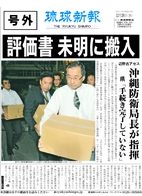
Go To Extra edition(PDF)
At around 4:00am on December 28, the Okinawa Defense Bureau used four cars to take part of the evaluation report to the Okinawa Prefectural Office. Because protests by citizens’ groups forced the Bureau to take some of the report back, the Prefectural Government insists that the submission process is not yet complete. As of 9:00am, citizens’ groups were still trying to prevent the Bureau from bringing the report into the office, causing a tense standoff. There will be strident opposition in Okinawa about the way the Bureau delivered the evaluation report documents before dawn.
Okinawa Defense Director Ro Manabe accompanied staff from the Bureau when transporting the report and gave instructions during the process, but he did not reply to any questions posed by news reporters.
Entering the Office through a side door in the early hours of the morning, about 20 staff who came in cars each carrying a cardboard box carried 16 boxes into the building security guards’ room, where there was only one security guard on duty at the time.
One member of the citizen groups who had been keeping watch since 1:00am that day fiercely protested against the staff of the Bureau, and as members of the media reported on what was happening, Defense Bureau staff took the boxes containing some of report documents back to their cars. Three cars, including the one carrying Manabe, left the Office about five minutes after they arrived.
In response to questions from reporters, Haruo Morita, the head of the Planning Division of the Okinawa Defense Bureau, who was in a parked car, said, “The boxes contain documents regarding the report. There are over 20 boxes here, but we have not brought some of those boxes in to the office.” Morita did not clearly indicate whether or not the submission process is now complete because some of the boxes have not yet been brought to the Office.
After the staff of the Bureau left, staff of the Okinawa Prefectural Government (OPG), including Toru Uehara, head of the Local Administration Department, arrived at the scene. Uehara said, “Acceptance of the documents is not complete because the central government has not completed all the prescribed procedures, such as getting seals stamped on some of the documents.”
Meeting members of the Okinawa Prefectural Assembly who visited the Office that day before noon, head of the Executive Office of the Governor Susumu Matayoshi said, “At this stage, we are not saying that we have officially received the evaluation report. However, the OPG is obliged to take receipt of the report if the documentation is completed. We intend to check to see if all forms are filled out correctly.”
(English translation by T&CT, Mark Ealey)
Go To Japanese
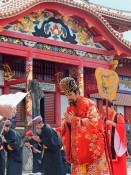
January 3, 2011 Ryukyu Shimpo
From January 1 to 3, an event called Shinshun no Utage or New Year’s Banquet was held at Shuri Castle in Naha. The Chouhaiokishiki or Imperial Court New Year’s morning ceremony, which used to take place at Shuri Castle on New Year’s day during the Ryukyu Dynasty, was revived and many tourists enjoyed watching the solemn ceremony.
On January 1 and 2, Ninufanu-unufe, which is one of New Year’s ceremonies and an occasion to pray to the gods was carried out. The King appeared in front of the Una forecourt of the Seiden main hall in Shuri Castle. After lighting some incense, he prayed for a peaceful year.
On January 3, the Ryukyu no Utage or Banquet of the Ryukyus was held. Takashi Inoue, a company worker from Tokyo said, “It was a solemn event. This year will be a good year.”
For further information contact the Shurijo Castle Park Management Center. Telephone: 098 (886) 2020.
(English translation by T&CT, Lima Tokumori and Mark Ealey)
Go To Japanese

Go To Video
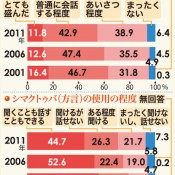
January 1, 2012 Ryukyu Shimpo
The Ryukyu Shimpo conducted an attitude survey in November 2011 in order to gain an insight into the character of Okinawan people and to detect trends in society. This is the third of its kind after those carried out in 2001 and 2006. The percentage who answered, “I get along well or reasonably well with my neighbors” was 54.1%, down 8.4 percentage points compared to 2001 and 5.3 points down on 2006, indicating the quickening trend towards shallow relationships in the community.
The figure for those who answered, “I can speak Shimakutuba or the Okinawan dialect” was 44.7%, down 11.1% on 2001, with the percentage for this answer falling below 50% for the first time. Particularly notable was that 90% people in their 20s and 30s said that they are not able to speak the language, indicating a critical situation on this front. The percentage of people concerned about the presence of U.S. military bases was 44.2%, up 9.7% compared to 2006. It has risen from fourth position to become the next matter of concern after low income, which attracted 61.1% of responses.
With regard to neighborly ties, 38.9% answered “Only exchange greetings,” up 7.1 points compared to 2001, “Very little” was also up 1.5 points to 6.4%. Among the young generation in their 20s and 30s, the result combining the two answers accounted for 70%, which is radically different from those in their 40s. A total of 47.9% of people said that they took part in the community events and festivals “often” or “sometimes” which was down 9.9 points compared to 2001. On the other hand, people who answered that they “hardly ever” or “never” participate in such events increased by 9.9 percentage points.
While 26.3% of respondents commented that they can understand but cannot speak Shimakutuba, 21.7% said they have some ability in the language, and 7.3% of people said that they don’t know it at all. There are significant gaps among the various age groups, especially with regard to the answer “I can both speak and understand the language.” The percentage is 86.8% for people in their 70s or older, 75.0% for those in their 60s, 51.5% for the 50s, 27.9% for the 40s, 13.7% for the 30s and 10.1% for those in their 20s.
The answer “reduce” or “remove” the U.S. military bases reached 65.9%. With regard to the future political status of Okinawa, 61.8% want to continue its current status as a prefecture of Japan, 15.3% want it to be a special administrative region which includes the option to be an autonomous state, and 4.7% want independence. Pride in being Uchinanchu and towards Okinawan culture is about 90%, which remains as high as in 2001 and 2006.
In the survey, 2000 Okinawan residents over 20 years of age were randomly selected from a list of eligible voters. Polltakers visited the 1137 people who responded and carried out interviews between November 11 and 24, 2011. The response rate was 56.9%.
(English translation by T&CT, Shinako Oyakawa and Mark Ealey)
Go To Japanese
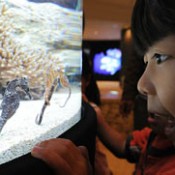
January 1, 2012 Ryukyu Shimpo
As it does every year, to celebrate the Year of the Dragon the Okinawa Churaumi Aquarium in Motobu organized a special display of creatures. Visitors enjoyed watching sea horses and other creatures named after dragons as they swam gracefully in their tanks.
The crowned seahorse is approximately 10 centimeters long and appears in colors such as bright yellow, brown or black. Their calm appearance as they float in the cylindrical tank attracted a great deal of attention from visitors to the aquarium.
Many people, including tourists and family groups, took photographs of the seahorses. Eighty-six year-old Kumiko Ura visited the aquarium from Kunigami with her family who had come back to Okinawa on a visit. She said, “In the sea all creatures exist in harmony with each other. I wish that the human world could be the same.”
(English translation by T&CT, Mark Ealey)
Go To Japanese

Go To Video
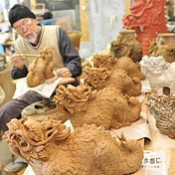
December 27, 2011 Ryukyu Shimpo
As the year wound down, workers at Toushingama in Yomitan Village were busy making items of pottery in the shape of a dragon, next year’s Chinese zodiac animal.
“Just as the dragon rises up, I really do hope that next year will be a good year for all,” said Masakazu Soma, the head of Toushingama. He worked hard to make sake jars and figurines decorated with the design of the dragon.
The dragon is an auspicious creature – the only mystical animal of the zodiac. From around November, shops at Tsuboya in Naha, which sell pottery including lucky charms made by Soma, have even received orders from outside the prefecture. In Okinawa, people often also purchase such charms to commemorate the year of a child’s birth or as a gift.
(English translation by T&CT, Lima Tokumori and Mark Ealey)
Go To Japanese
December 27, 2011 Ryukyu Shimpo
The Okinawan Products Associate co. Ltd will test markets for Okinawan products in next March at two different places of Shanghai and Shenzhen in China. This is part of the Project for the Market-Enhancing Strategy of Okinawan Products into China and will be carried out in an attempt to understand the needs of the Chinese market before moving ahead in China with products for export. The Association is now gathering Okinawan products to sell in the test-marketing. On December 26, there was a briefing session for companies at the Okinawa Industry Support Center in Naha.
Closing date for the submission of products is January 12, 2012 after which the Association will select approximately 50 items from those submitted. In addition to the test-marketing, with the aim of carrying out market research and to encourage the spread of Okinawan products in China, it will promote the idea of using a website and will issue material that includes details of merchandise from the 2011 fiscal year.
In the briefing session, information was provided on the import restrictions for Japanese agricultural products and foods by the Chinese government. It was explained that only two kinds of fruit – apples and pears, can be imported from Japan, and that the import of health foods and cosmetics requires the approval of the Chinese government. Also it was pointed out that raw materials from ten prefectures such as Fukushima, Tokyo and Miyagi are prohibited to use and depending on certificates of origin or foods, radioactive substance inspection certificates are required.
For further information with regard to the test-marketing contact the Okinawan Products Associate co. Ltd. Telephone: 098 (859) 6325.
(English translation by T&CT, Lima Tokumori and Mark Ealey)
Go To Japanese
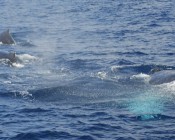
December 29, 2011 Yoshikazu Miyazato correspondent of Ryukyu Shimpo
In the morning of December 28, the first five humpback whales of this season were confirmed as being seen in the sea to the west side of Zamami Island. They are usually first seen in the middle of December, but this year sightings were delayed because of continued bad weather.
At around 9:00am, their migration was seen from an observation platform on the island. Kiyoshi Miyagi, who runs a diving business on Zamami, went whale watching with German tourists at an area eight kilometers from the island. They were able to see two bull whales and one cow whale and it seemed as though they were communicating with each other.
This continued for about an hour, after which two of the whales swam westwards in the direction of Kume Island.
(English translation by T&CT, Lima Tokumori and Mark Ealey)
Go To Japanese
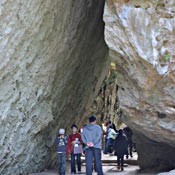
December 28, 2011 Ryukyu Shimpo
On December 27, the Nanjo Municipal Office announced that from 2012 it will close the sacred prayer site Seifa Utaki for six days a year from May 1 to 3 and October 1 to 3 of the lunar calendar.
After being designated as a World Heritage Site in 2000, the numbers of tourists has increased every year and it is thought that about 400000 people will have visited the site by the end of 2011. However, improper behavior by visitors, such as taking photographs by clambering up an altar has been a problem. The municipal authorities have received complaints from worshippers and are also concerned about the impact on the local natural environment.
Nanjo City authorities will restrict access to the site on a trial basis to maintain the tranquility of the sacred spot in an attempt to improve the behavior of visitors and out of consideration for the preservation of the natural environment. These new regulations will apply to everyone including worshippers and officials and in order to convey the culture surrounding the lunar calendar, the municipal authorities set the dates according to that calendar, with a spokesperson saying, “In Okinawa, many annual events follow the lunar calendar.”
At a news conference, Mayor Keishun Koja said, “Seifa Utaki is special sacred prayer site not a tourist spot. We would like to encourage people to preserve it so it can be passed on to the next generation. We merely ask for cooperation and assistance.”
Eishin Futenma, president of the Association for Introducing the Cultural Properties of Chinen said, “Deciding upon the days when it will be closed indicates the City’s intention to improve the environment of the site, but it would have been better if they had set days during the summer vacation since the site gets more than 2000 visitors a day during that period.”
(English translation by T&CT, Shinako Oyakawa and Mark Ealey)
Go To Japanese
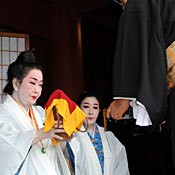
December 26, 2011 Ryukyu Shimpo
On December 25, a dedication exercise to present the Ryukyu Kingdom with wakamizu or sacred water called Nuubii no Hounou sai was revived at Shuri Castle. The water was drawn from Ookawa in the Hedo district of Kunigami and Hiijaa in Takushi in Urasoe. The solemn performance was organized by the Shuri Tonokura Community Association and was watched by many residents and tourists.
A group of forty people dressed in the period costume of officers and female priests called noro held sacred water as they paraded down the street. The party mixed the water from Ookawa and Takushi Hiijaa in front of the main gate called Enkaku-ji Soumon and entered through the rear entrance of the main hall through the Kyukeimon gate to offer a tribute of water to the court lady Amushirare.
During the Ryukyu Dynasty this ritual was performed to greet the New Year and to wish for peace and calm in the Kingdom, as well as the good health and longevity of the king. “This year, we had a lot of gloomy news about issues such as the earthquake, so there was a certainly lot of feeling involved when I offered the water and requested good fortune for the coming year,” said Masao Miyagi the president of the Community Association.
(English translation by T&CT, Shinako Oyakawa and Mark Ealey)
Go To Japanese

Go To Video
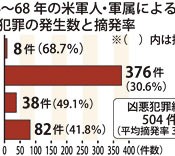
December 23, 2011 Ryukyu Shimpo
A total of 5367 crimes were committed by U.S. military personnel in the five years from 1964 to 1968 under the U.S. Military Administration of Okinawa. On December 22, a Foreign Ministry document released stated that while 504 violent crimes such as murders, robberies, and rapes were committed, only 33.6% of all the crimes committed actually resulted in prosecution.
According to statistics attached to a confidential report entitled “Civil affairs related basic issues and Okinawa’s reversion” dated January 19, 1970, 973 crimes including 77 violent crimes were committed in Okinawa in 1964. The number of recorded crimes committed there by U.S. military personnel in 2010 was 71, which means that approximately 14 times more crimes were committed in 1970.
The breakdown of violent crimes was 55 robberies (prosecution rate 36.3%), five arsons (40%), and 17 rapes (52.9%) in 1964. In 1966, two murders occurred but they did not lead to prosecution, 101 robberies (37.6%), seven cases of arson (57.1%), and 17 rapes (52.9%).
The report covers the transfer of judiciary proceedings from the U.S. Military Administration to Japanese domestic laws after the reversion of Okinawa.
(English translation by T&CT, Megumi Chibana and Mark Ealey)
Go To Japanese
December 23, 2011 Ryukyu Shimpo
According to diplomatic documents declassified on December 22, 2011, the date of Okinawa’s reversion to Japanese sovereignty was set to match the completion of the removal of nuclear weapons stored in U.S. military bases in Okinawa.
While the Japanese side requested that Okinawa be returned to Japan on April 1, the United States rejected this timing, claiming that it was difficult to complete the removal of so-called special weapons (nuclear weapons) from the islands by then. It was already known that America postponed the reversion, no clear reasons had previously been disclosed.
On July 7, 1971, officials of the Ministry of Foreign Affairs of Japan and the U.S. Embassy of Japan negotiated the reversion of Okinawa. During the negotiations, the U.S. side indicated that it would be impossible to complete the removal of nuclear weapons from its military bases in Okinawa by April 1, 1971, and on that basis, U.S. representatives stated that they doubted that reversion would be possible by that date.
In addition, the Americans sought to justify the postponement of the reversion by claiming that it would be difficult to start the handover process of regional defense in Okinawa from April 1 and asserted that the reversion should be carried out after that date.
During the foreign ministerial conference between Japan and the United States on June 9, 1971, Japanese Foreign Minister Kiichi Aichi stated that the Okinawan people agreed with the request for reversion of sovereignty on April 1, but Secretary of State William P. Rogers dismissed this, saying that it would extremely be difficult to meet that deadline. For his part, Rogers did not mention the removal of nuclear weapons deployed in Okinawa, and only explained that the U.S. Congress may disapprove of negotiations on the reversion date occurring at that late stage in the piece.
On January 1, 1972, Prime Minister Eisaku Sato and President Richard Nixon officially decided to return Okinawa to Japan on May 15, 1972.
(English translation by T&CT, Mark Ealey)
Go To Japanese













 Webcam(Kokusai Street)
Webcam(Kokusai Street)


